
Mughal Weapons
Encyclopedia
Mughal Weapons, The Military of the Mughal Empire
used a variety of weapons in their conquests throughout the centuries. various types of: swords
, bow (weapon)
& arrows
, horses, camels, elephants, various types of cannons (some of them the worlds largest), muskets and Flintlock Blunderbuss. Mughal weapons were greatly evolved during the ruling periods of Babur
, Akbar, Aurangzeb
and lastly Tipu Sultan
, Mughal weapons have become very popular due to the recent RTS game Age of Empires 3: The Asian Dynasties expansion.
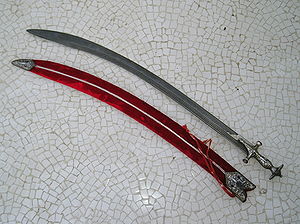 A major change was brought about in the shape and quality of swords since after the advent of the Mughal rule. They brought with them the curved sword, as opposed to the heavy straight swords with rounded ends as was in use at the time. These were sleek, sharp. Curved and made of a superior alloy of iron. The most superior quality blades were imported from Iran and made of crucible steel which gave it a crystalline appearance was capable of cutting deep into the armour and bodies of their adversaries. The ruler always carried with him a sword enclosed in a red sheath. The `Indo-Muslim` hilt, with its typical dish-shaped pommel, seems to have been introduced by the Mughals, and spread throughout India together with the curved-blade, or Talwar. The Mughals and their successors continued to patronize this tradition through royal workshops or Karkhana, and some of the most exquisite items still in existence came from this source
A major change was brought about in the shape and quality of swords since after the advent of the Mughal rule. They brought with them the curved sword, as opposed to the heavy straight swords with rounded ends as was in use at the time. These were sleek, sharp. Curved and made of a superior alloy of iron. The most superior quality blades were imported from Iran and made of crucible steel which gave it a crystalline appearance was capable of cutting deep into the armour and bodies of their adversaries. The ruler always carried with him a sword enclosed in a red sheath. The `Indo-Muslim` hilt, with its typical dish-shaped pommel, seems to have been introduced by the Mughals, and spread throughout India together with the curved-blade, or Talwar. The Mughals and their successors continued to patronize this tradition through royal workshops or Karkhana, and some of the most exquisite items still in existence came from this source
The finest among the swords was considered to be the Shamsher. It was a curved sword with a sharp edge that was primarily used as a cutting weapon. This type of sword was of great value and in fact later went on to become one of the most preferred swords and part of the couture of the Hindu Rajput warriors, called the Khanda.
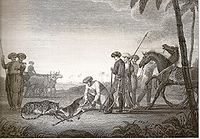 From the late fifteenth century there was widespread use of firearms-cannons, muskets and mortars. They were considerably improved and extensively used during the reign of Akbar. In fact the emperor himself had an impressive collection of arms categorized according to weight, make etc. were a large number of musketeers in the Mughal army as muskets tended to overheat and were slow to reload, Seopys who employed the Musket were given the title Barkandaz
From the late fifteenth century there was widespread use of firearms-cannons, muskets and mortars. They were considerably improved and extensively used during the reign of Akbar. In fact the emperor himself had an impressive collection of arms categorized according to weight, make etc. were a large number of musketeers in the Mughal army as muskets tended to overheat and were slow to reload, Seopys who employed the Musket were given the title Barkandaz
.
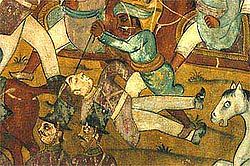 The first Military specializing in rocket artillery were the Cushoon of Tipu Sultan
The first Military specializing in rocket artillery were the Cushoon of Tipu Sultan
. Haider Ali
and Tipu Sultan as regarded as pioneers in the use of solid fuel rocket technology or missiles for military use. A military tactic developed by Tipu Sultan and his father, Haidar Ali was the use of mass attacks with rocket brigades on infantry formations. Tipu Sultan wrote a military manual called Fathul Mujahidin
in which 200 rocket men were assigned to each Mysore "Cushoon" (brigade). Mysore had 16 to 24 Cushoons of infantry. The areas of town where rockets and fireworks were manufactured were known as Taramandal Pet ("Galaxy Market"). It was only after Tipu's death that the technology eventually reached Europe. The Royal Woolwich Arsenal's beginning a military rocket R&D program in 1801 that relied on the technology learned from Mysore.
The Mysore rockets utilized by Hyder Ali
during the Battle of Pollilur
were much more advanced than the British East India Company
had previously seen, chiefly because of the use of iron tubes for holding the propellant; this enabled higher thrust and longer range for the missile (up to 2 km range). After Tipu Sultan
's eventual defeat in the Fourth Anglo-Mysore War
and the capture of the Mysore iron rockets, they were influential in British rocket development, inspiring the Congreve rocket
, which was soon put into use in the Napoleonic Wars
.
, was originally a rank during the Mughal
period. The term had been used to define a horse-soldier belonging to the cavalry troops of the Mughal
armies in South Asia
. It is also used more specifically of a mounted orderly, escort or guard. It was also the rank held by ordinary cavalry troopers, equivalent to Sepoy
in the infantry.
after the 16th century, consisted of a soldier on a camel with a mounted swivel
gun (a small falconet), which was hinged on a metal fork-rest protruding from the saddle of the animal. In order to fire the cannon, the camel would be put on its knees. The name may be derived from Arabic zambūr, hornet (possibly in reference to the sound earlier camel-mounted crossbows made). The mobility of the camel combined with the flexibility and heavy firepower of the swivel gun to make an intimidating military unit.
The soldier type was probably introduced by Egyptian Mamluk
warriors who originally mounted large crossbows on the camels, the Zamburak was rapidly adopted by especially by the Persian Safavid armies, the Zamburak was introduced into the Mughal Empire
by Mughal Emperor Humayun
, Zamburak were used against the invading British
in the Anglo-Afghan Wars.
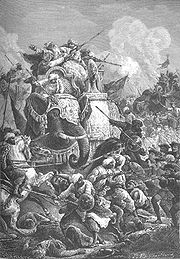 The elephant had a ceremonial and almost power status in the traditional Mughal court. It did have a primary role on the battlefield in early Mughal armies but was supplanted by the faster horse archer. Despite this there were often several thousands, if not tens of thousands of elephants in the Mughal army. The elephant could serve the role of a command platform to keep the general above the crowd of the battle, although it also meant that if the soldiers saw an empty seat on top of an elephant that they may think that the general was dead and flee. l seat Elephants were also kept in the reserve to move in as a very obvious block or counter penetration force if the Mughal battle line was broken. As gunpowder weapons became more prevalent on the Indian battlefield the elephant lost its place even more. It was relegated to being a beast of burden to move weapons and supplies to the front line. It did however maintain the besieging role to pull down fortifications.
The elephant had a ceremonial and almost power status in the traditional Mughal court. It did have a primary role on the battlefield in early Mughal armies but was supplanted by the faster horse archer. Despite this there were often several thousands, if not tens of thousands of elephants in the Mughal army. The elephant could serve the role of a command platform to keep the general above the crowd of the battle, although it also meant that if the soldiers saw an empty seat on top of an elephant that they may think that the general was dead and flee. l seat Elephants were also kept in the reserve to move in as a very obvious block or counter penetration force if the Mughal battle line was broken. As gunpowder weapons became more prevalent on the Indian battlefield the elephant lost its place even more. It was relegated to being a beast of burden to move weapons and supplies to the front line. It did however maintain the besieging role to pull down fortifications.
The elephant was as much a victim of gunpowder as was the European knight. Unlike the knight however, the elephant did not evolve on the battlefield to a new role but disappeared from the front lines and was pushed further back.
word Sipahi, the word was commonly used by Mughal
s and Safavids to describe individual infantry soldiers, the Ottoman
Turks used the word to describe the elite Cavalry Sipahi
.
The Sipahi were native Mughal musketeer units in the Mughal Empire
s basic military units, most of them carried Talwar
s and Sheilds, a special class known as the Atishbaz
carried Mughal guns such as Muskets, the Atishbaz served under a Mir Atish (Mir of gunpowder
weaponry).
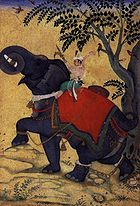 A howdah, or houdah, also known as Hathi Howdah, a carriage which is positioned on the back of an elephant, or occasionally some other animal, used most often in the past to carry wealthy people or for use in hunting or warfare. It was also a symbol of wealth for the owner, and as a result was decorated with expensive gems.
A howdah, or houdah, also known as Hathi Howdah, a carriage which is positioned on the back of an elephant, or occasionally some other animal, used most often in the past to carry wealthy people or for use in hunting or warfare. It was also a symbol of wealth for the owner, and as a result was decorated with expensive gems.
Most notable are the Golden Howdah, used traditionally during the Jamboo Savari (Elephant Procession) of the famous Mysore Dasara. The Museum at Mehrangarh Fort, Jodhpur, Rajasthan has a gallery of royal Howdahs.
 A howdah, or houdah, also known as Hathi Howdah, a carriage which is positioned on the back of an elephant, or occasionally some other animal, used most often in the past to carry wealthy people or for use in hunting or warfare. It was also a symbol of wealth for the owner, and as a result was decorated with expensive gems.
A howdah, or houdah, also known as Hathi Howdah, a carriage which is positioned on the back of an elephant, or occasionally some other animal, used most often in the past to carry wealthy people or for use in hunting or warfare. It was also a symbol of wealth for the owner, and as a result was decorated with expensive gems.
Most notable are the Golden Howdah, used traditionally during the Jamboo Savari (Elephant Procession) of the famous Mysore Dasara. The Museum at Mehrangarh Fort, Jodhpur, Rajasthan has a gallery of royal Howdahs.
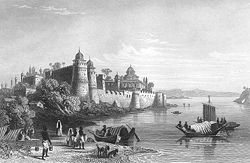
The Mughals also maintained various river fleets of Dhow
s, which transported soldiers over rivers and fought rebels. Among its admiral
s were Yahya Saleh
, Munnawar Khan
, Sidi Yaqub
, and Muhammad Saleh Kamboh
. The Mughals also protected the Siddi
s of Janjira and the ports of Thatta
. Its sailors were renowned and often voyaged to China and the East African Swahili Coast, together with some Mughal subjects carrying out private-sector trade.
Mughal Empire
The Mughal Empire , or Mogul Empire in traditional English usage, was an imperial power from the Indian Subcontinent. The Mughal emperors were descendants of the Timurids...
used a variety of weapons in their conquests throughout the centuries. various types of: swords
Swords
A sword is a cutting/thrusting weapon made of metal. Sword or swords may also refer to:* Swords, County Dublin, Ireland* Suit of swords, a suit in Latin-suited playing cards and Tarot decks* SWORDS, a ground-based military robot...
, bow (weapon)
Bow (weapon)
The bow and arrow is a projectile weapon system that predates recorded history and is common to most cultures.-Description:A bow is a flexible arc that shoots aerodynamic projectiles by means of elastic energy. Essentially, the bow is a form of spring powered by a string or cord...
& arrows
Arrows
Arrows Grand Prix International was a British Formula One team active from to . For a period of time, it was also known as Footwork.-Origins :...
, horses, camels, elephants, various types of cannons (some of them the worlds largest), muskets and Flintlock Blunderbuss. Mughal weapons were greatly evolved during the ruling periods of Babur
Babur
Babur was a Muslim conqueror from Central Asia who, following a series of setbacks, finally succeeded in laying the basis for the Mughal dynasty of South Asia. He was a direct descendant of Timur through his father, and a descendant also of Genghis Khan through his mother...
, Akbar, Aurangzeb
Aurangzeb
Abul Muzaffar Muhy-ud-Din Muhammad Aurangzeb Alamgir , more commonly known as Aurangzeb or by his chosen imperial title Alamgir , was the sixth Mughal Emperor of India, whose reign lasted from 1658 until his death in 1707.Badshah Aurangzeb, having ruled most of the Indian subcontinent for nearly...
and lastly Tipu Sultan
Tipu Sultan
Tipu Sultan , also known as the Tiger of Mysore, was the de facto ruler of the Kingdom of Mysore. He was the son of Hyder Ali, at that time an officer in the Mysorean army, and his second wife, Fatima or Fakhr-un-Nissa...
, Mughal weapons have become very popular due to the recent RTS game Age of Empires 3: The Asian Dynasties expansion.
Weapons used in Mughal Warfare
A major development in war was made by the introduction of gunpowder in Indian battle, a feat never accomplished before. Among the commonly used weapons are the sword and dagger, guns and cannon, archery and the extensive use of cavalry and infantry during war.Talwar

The finest among the swords was considered to be the Shamsher. It was a curved sword with a sharp edge that was primarily used as a cutting weapon. This type of sword was of great value and in fact later went on to become one of the most preferred swords and part of the couture of the Hindu Rajput warriors, called the Khanda.
Daggers
Apart from swords, the Muslim armies also used the dagger for purposes of warfare. This was a sharp two-edged instrument that was kept hidden in the boot of the horseman (Khuff).This was used as a secondary weapon.Archery
The use of bows and arrows, after its skilled usage in the hands of the Central Asian Turks, continued to be practiced by the Mughals. The Bow, typically double- curved, was carried in a container known as the Qirban whereas arrows were carried in quivers called Tarkash. The Mughals were quite skilled in archery and have even been known to poison the tip of the arrows to incapacitate the enemy. Special care was taken even in the manufacturing of these weapons. Bow-makers were sent to special training centres in Damascus and then only the best were allowed to manufacture the same for the purpose of warfare.Cannons
The Mughals introduced in India the system of gunfire shot from cannons. This was a very effective ploy in the art of war as apart from the damage on impact, the explosion served to disorient and frighten the horses and elephants. This allowed the cavalry to charge in and prevent the enemies from forming strategies and countering the attack. Cannons, though extremely effective, were quite problematic to transport because of their size and weight. The cannon balls themselves were five hundred forty pounds and the cannon had to be matched accordingly to bear this weight.Muskets

Matchlock
The matchlock was the first mechanism, or "lock" invented to facilitate the firing of a hand-held firearm. This design removed the need to lower by hand a lit match into the weapon's flash pan and made it possible to have both hands free to keep a firm grip on the weapon at the moment of firing,...
.
Flintlock blunderbuss
Other weapons
other weapons used by the Mughals include maces (Gada), with a dome shaped head and a handle and knob at the end, Piyazi and Garguz shaped like an onion and a flower with eight petals respectively. In order to break the helmet and armour of the enemy soldiers, Shapshar and Amud were used. War axes were great favourites of the infantry as were the Jaghnol-a sharp blade fitted with a spike at the back to pierce through the armour. The tiger claw or Bagh Nakh was another lethal weapon used to disembowel an enemy. This was often used for the purpose of political assassinationCushoon

Tipu Sultan
Tipu Sultan , also known as the Tiger of Mysore, was the de facto ruler of the Kingdom of Mysore. He was the son of Hyder Ali, at that time an officer in the Mysorean army, and his second wife, Fatima or Fakhr-un-Nissa...
. Haider Ali
Haider Ali
Haider Ali is considered one the best boxers in the history of Pakistan boxing. His explosive speed and resourcefulness made him a constant threat to opposing boxers....
and Tipu Sultan as regarded as pioneers in the use of solid fuel rocket technology or missiles for military use. A military tactic developed by Tipu Sultan and his father, Haidar Ali was the use of mass attacks with rocket brigades on infantry formations. Tipu Sultan wrote a military manual called Fathul Mujahidin
Fathul Mujahidin
Fathul Mujahidin is a military manual that was written by Tippu Sultan, a ruler of the Kingdom of Mysore, considered a pioneer in the use of rocket artillery. He used rockets in battle with the British Army in the 1792 Siege of Srirangapatna, a battle at the end of the Third Anglo-Mysore War.Tipu...
in which 200 rocket men were assigned to each Mysore "Cushoon" (brigade). Mysore had 16 to 24 Cushoons of infantry. The areas of town where rockets and fireworks were manufactured were known as Taramandal Pet ("Galaxy Market"). It was only after Tipu's death that the technology eventually reached Europe. The Royal Woolwich Arsenal's beginning a military rocket R&D program in 1801 that relied on the technology learned from Mysore.
Rocket
See also:Mysorean rocketsMysorean rockets
Mysorean rockets were the first iron-cased rockets that were successfully deployed for military use. Hyder Ali, the 18th century ruler of Mysore, and his son and successor, Tipu Sultan used them effectively against the British East India Company...
The Mysore rockets utilized by Hyder Ali
Hyder Ali
Hyder Ali was the de facto ruler of the Kingdom of Mysore in southern India. Born Hyder Naik, he distinguished himself militarily, eventually drawing the attention of Mysore's rulers...
during the Battle of Pollilur
Battle of Pollilur
The Battle of Pollilur, also known as the Battle of Polilore or Battle of Perambakam, took place on 10 September 1780 at Pollilur near the city of Kanchipuram in present-day Tamil Nadu state, India as part of the Second Anglo-Mysore War...
were much more advanced than the British East India Company
British East India Company
The East India Company was an early English joint-stock company that was formed initially for pursuing trade with the East Indies, but that ended up trading mainly with the Indian subcontinent and China...
had previously seen, chiefly because of the use of iron tubes for holding the propellant; this enabled higher thrust and longer range for the missile (up to 2 km range). After Tipu Sultan
Tipu Sultan
Tipu Sultan , also known as the Tiger of Mysore, was the de facto ruler of the Kingdom of Mysore. He was the son of Hyder Ali, at that time an officer in the Mysorean army, and his second wife, Fatima or Fakhr-un-Nissa...
's eventual defeat in the Fourth Anglo-Mysore War
Fourth Anglo-Mysore War
The Fourth Anglo-Mysore War was a war in South India between the Sultanate of Mysore and the British East India Company under the Earl of Mornington....
and the capture of the Mysore iron rockets, they were influential in British rocket development, inspiring the Congreve rocket
Congreve rocket
The Congreve Rocket was a British military weapon designed and developed by Sir William Congreve in 1804.The rocket was developed by the British Royal Arsenal following the experiences of the Second, Third and Fourth Mysore Wars. The wars fought between the British East India Company and the...
, which was soon put into use in the Napoleonic Wars
Napoleonic Wars
The Napoleonic Wars were a series of wars declared against Napoleon's French Empire by opposing coalitions that ran from 1803 to 1815. As a continuation of the wars sparked by the French Revolution of 1789, they revolutionised European armies and played out on an unprecedented scale, mainly due to...
.
Sowar
The word Sowar means 'The one who rides' in PersianPersian language
Persian is an Iranian language within the Indo-Iranian branch of the Indo-European languages. It is primarily spoken in Iran, Afghanistan, Tajikistan and countries which historically came under Persian influence...
, was originally a rank during the Mughal
Mughal Empire
The Mughal Empire , or Mogul Empire in traditional English usage, was an imperial power from the Indian Subcontinent. The Mughal emperors were descendants of the Timurids...
period. The term had been used to define a horse-soldier belonging to the cavalry troops of the Mughal
Mughal Empire
The Mughal Empire , or Mogul Empire in traditional English usage, was an imperial power from the Indian Subcontinent. The Mughal emperors were descendants of the Timurids...
armies in South Asia
South Asia
South Asia, also known as Southern Asia, is the southern region of the Asian continent, which comprises the sub-Himalayan countries and, for some authorities , also includes the adjoining countries to the west and the east...
. It is also used more specifically of a mounted orderly, escort or guard. It was also the rank held by ordinary cavalry troopers, equivalent to Sepoy
Sepoy
A sepoy was formerly the designation given to an Indian soldier in the service of a European power. In the modern Indian Army, Pakistan Army and Bangladesh Army it remains in use for the rank of private soldier.-Etymology and Historical usage:...
in the infantry.
Zamburak
The Zamburak was a specialized form of camel cavalry and mobile artillery from the Muslim WorldMuslim world
The term Muslim world has several meanings. In a religious sense, it refers to those who adhere to the teachings of Islam, referred to as Muslims. In a cultural sense, it refers to Islamic civilization, inclusive of non-Muslims living in that civilization...
after the 16th century, consisted of a soldier on a camel with a mounted swivel
Swivel
A swivel is a connection that allows the connected object, such as a gun or chair, to rotate horizontally and/or vertically. A common design for a swivel is a cylindrical rod that can turn freely within a support structure. The rod is usually prevented from slipping out by a nut, washer or...
gun (a small falconet), which was hinged on a metal fork-rest protruding from the saddle of the animal. In order to fire the cannon, the camel would be put on its knees. The name may be derived from Arabic zambūr, hornet (possibly in reference to the sound earlier camel-mounted crossbows made). The mobility of the camel combined with the flexibility and heavy firepower of the swivel gun to make an intimidating military unit.
The soldier type was probably introduced by Egyptian Mamluk
Mamluk
A Mamluk was a soldier of slave origin, who were predominantly Cumans/Kipchaks The "mamluk phenomenon", as David Ayalon dubbed the creation of the specific warrior...
warriors who originally mounted large crossbows on the camels, the Zamburak was rapidly adopted by especially by the Persian Safavid armies, the Zamburak was introduced into the Mughal Empire
Mughal Empire
The Mughal Empire , or Mogul Empire in traditional English usage, was an imperial power from the Indian Subcontinent. The Mughal emperors were descendants of the Timurids...
by Mughal Emperor Humayun
Humayun
Nasir ud-din Muhammad Humayun was the second Mughal Emperor who ruled present day Afghanistan, Pakistan, and parts of northern India from 1530–1540 and again from 1555–1556. Like his father, Babur, he lost his kingdom early, but with Persian aid, he eventually regained an even larger one...
, Zamburak were used against the invading British
United Kingdom
The United Kingdom of Great Britain and Northern IrelandIn the United Kingdom and Dependencies, other languages have been officially recognised as legitimate autochthonous languages under the European Charter for Regional or Minority Languages...
in the Anglo-Afghan Wars.
War elephants

The elephant was as much a victim of gunpowder as was the European knight. Unlike the knight however, the elephant did not evolve on the battlefield to a new role but disappeared from the front lines and was pushed further back.
Sepoy
The word sepoy is a disambiguation of the word PersianPersian language
Persian is an Iranian language within the Indo-Iranian branch of the Indo-European languages. It is primarily spoken in Iran, Afghanistan, Tajikistan and countries which historically came under Persian influence...
word Sipahi, the word was commonly used by Mughal
Mughal Empire
The Mughal Empire , or Mogul Empire in traditional English usage, was an imperial power from the Indian Subcontinent. The Mughal emperors were descendants of the Timurids...
s and Safavids to describe individual infantry soldiers, the Ottoman
Ottoman Turks
The Ottoman Turks were the Turkish-speaking population of the Ottoman Empire who formed the base of the state's military and ruling classes. Reliable information about the early history of Ottoman Turks is scarce, but they take their Turkish name, Osmanlı , from the house of Osman I The Ottoman...
Turks used the word to describe the elite Cavalry Sipahi
Sipahi
Sipahi was the name of several Ottoman cavalry corps...
.
The Sipahi were native Mughal musketeer units in the Mughal Empire
Mughal Empire
The Mughal Empire , or Mogul Empire in traditional English usage, was an imperial power from the Indian Subcontinent. The Mughal emperors were descendants of the Timurids...
s basic military units, most of them carried Talwar
Talwar
The talwar is a type of curved sword or sabre from India and modern-day Pakistan...
s and Sheilds, a special class known as the Atishbaz
Atishbaz
The Atishbaz are a Muslim community found in the state Uttar Pradesh in India. They also refer to themselves as Atishbaz Shaikh or sometimes just Shaikh, which is also a common surname. Atishbaz also known as darugar. The Uttar Pradesh Atishbaz have been granted Other Backward Class status...
carried Mughal guns such as Muskets, the Atishbaz served under a Mir Atish (Mir of gunpowder
Gunpowder
Gunpowder, also known since in the late 19th century as black powder, was the first chemical explosive and the only one known until the mid 1800s. It is a mixture of sulfur, charcoal, and potassium nitrate - with the sulfur and charcoal acting as fuels, while the saltpeter works as an oxidizer...
weaponry).
Mahout

Most notable are the Golden Howdah, used traditionally during the Jamboo Savari (Elephant Procession) of the famous Mysore Dasara. The Museum at Mehrangarh Fort, Jodhpur, Rajasthan has a gallery of royal Howdahs.
Howdah

Most notable are the Golden Howdah, used traditionally during the Jamboo Savari (Elephant Procession) of the famous Mysore Dasara. The Museum at Mehrangarh Fort, Jodhpur, Rajasthan has a gallery of royal Howdahs.
Mughal Navy

The Mughals also maintained various river fleets of Dhow
Dhow
Dhow is the generic name of a number of traditional sailing vessels with one or more masts with lateen sails used in the Red Sea and Indian Ocean region. Some historians believe the dhow was invented by Arabs but this is disputed by some others. Dhows typically weigh 300 to 500 tons, and have a...
s, which transported soldiers over rivers and fought rebels. Among its admiral
Admiral
Admiral is the rank, or part of the name of the ranks, of the highest naval officers. It is usually considered a full admiral and above vice admiral and below admiral of the fleet . It is usually abbreviated to "Adm" or "ADM"...
s were Yahya Saleh
Yahya Saleh
Yahya Saleh Mughal Admiral and voyager, from Surat he was a fine navigator a humble devout Muslim Sailor he entered Mughal service during the rule of Akbar and in 1577 was trusted to lead members of the Mughal Emperor's personal harem to the Islamic holy cities of Mecca and Medina...
, Munnawar Khan
Munnawar Khan
Munnawar Khan Mughal Admiral born in Agra of Mughal decent, he entered service during the rule of Mughal Emperor Aurangzeb, during the conquest of Golconda, he first started his Naval training by protecting Mughal supply routes in narrow and difficult rivers, he was also promoted as the chief...
, Sidi Yaqub
Sidi Yaqub
Sidi Yaqub, was a Mughal Admiral from Murud Janjira, he fought the British East India Company during the Child's War. and later when the Ganj-i-Sawai and other Mughal vessels, were captured by the pirates: Henry Every and the fallen Thomas Tew....
, and Muhammad Saleh Kamboh
Muhammad Saleh Kamboh
Muhammad Saleh Kamboh Lahori was a noted Calligraphist and official biographer of Emperor Shah Jahan and the teacher of Mughal Emperor Aurangzeb. Though a widely read person, little is known of the life of Muhammad Saleh Kamboh other than the works he composed. He was son of Mir Abdu-lla, Mushkin...
. The Mughals also protected the Siddi
Siddi
The Siddi, Siddhi, or Sheedi , also known as Habshi, are an Indian and Pakistani ethnic group of Afro-Arab and/or Black African descent. The Siddi population is currently estimated to be 20,000–55,000, with Gujarat and Hyderabad in India the main population centre. Siddis are mainly Sufi Muslims,...
s of Janjira and the ports of Thatta
Thatta
Thatta is a historic town of 220,000 inhabitants in the Sindh province of Pakistan, near Lake Keenjhar, the largest freshwater lake in the country. Thatta's major monuments especially its necropolis at Makli are listed among the World Heritage Sites. The Shah Jahan Mosque is also listed...
. Its sailors were renowned and often voyaged to China and the East African Swahili Coast, together with some Mughal subjects carrying out private-sector trade.

